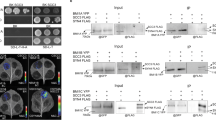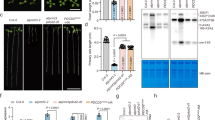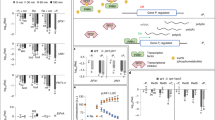Abstract
Polycomb group genes play crucial roles in the maintenance of the transcriptionally silenced state of genes for proper cell differentiation in animals and plants. While components of the polycomb repressive complex2 (PRC2) are evolutionarily conserved and their functions are extensively studied in plants, PRC1 differs considerably between animals and plants, and its functions in plants are as yet not well described. Previous studies have identified the Arabidopsis AtRING1a and AtRING1b as homologues of the animal PRC1 subunit RING1. Here, we show that the Atring1a Atring1b double mutant exhibits derepression of embryonic traits during vegetative growth. Accordingly, several key regulatory genes involved in embryogenesis and stem cell activity are ectopically expressed in the mutant. Furthermore, we show that the mutant phenotypes and increased expression of regulatory genes are enhanced by the PRC2 mutant clf. Finally, we show that three homologues of the animal PRC1-subunit ring-finger protein BMI1, AtBMI1a, AtBMI1b and AtBMI1c, can bind with AtRING1a or AtRING1b, and in addition, AtBMI1c can bind with LHP1. The Atbmi1a Atbmi1b double mutant shows derepression of embryonic traits similar to that of the Atring1a Atring1b double mutant. Interestingly, expression levels of AtBMI1a, AtBMI1b and AtBMI1c are elevated in the Atring1a Atring1b mutant and those of AtBMI1c, AtRING1a and AtRING1b are elevated in the Atbmi1a Atbmi1b mutant, suggesting a self-regulatory feedback mechanism. Taken together, our results illuminate crucial functions of the PRC1-like ring-finger components in stable repression of embryonic traits and regulatory genes for proper somatic growth.
Similar content being viewed by others
Log in or create a free account to read this content
Gain free access to this article, as well as selected content from this journal and more on nature.com
or
References
Schuettengruber B, Chourrout D, Vervoort M, Leblanc B, Cavalli G . Genome regulation by polycomb and trithorax proteins. Cell 2007; 128:735–745.
Pien S, Grossniklaus U . Polycomb group and trithorax group proteins in Arabidopsis. Biochem Biophys Acta 2007; 1769:375–382.
Alvarez-Venegas R . Regulation by polycomb and trithorax group proteins in Arabidopsis. In: Chang C ed. The Arabidopsis Book. Rockville, MD: American Society of Plant Biologists, 2010.
Shen WH, Xu L . Chromatin remodeling in stem cell maintenance in Arabidopsis thaliana. Mol Plant 2009; 2:600–609.
Turck F, Roudier F, Farrona S, et al. Arabidopsis TFL2/LHP1 specifically associates with genes marked by trimethylation of histone H3 lysine 27. PLoS Genet 2007; 3:e86.
Zhang X, Germann S, Blus BJ, Khorasanizadeh S, Gaudin V, Jacobsen SE . The Arabidopsis LHP1 protein colocalizes with histone H3 Lys27 trimethylation. Nat Struct Mol Biol 2007; 14:869–871.
Xu L, Shen WH . Polycomb silencing of KNOX genes confines shoot stem cell niches in Arabidopsis. Curr Biol 2008; 18:1966–1971.
Sanchez-Pulido L, Devos D, Sung ZR, Calonje M . RAWUL: a new ubiquitin-like domain in PRC1 ring finger proteins that unveils putative plant and worm PRC1 orthologs. BMC Genomics 2008; 9:308.
Qin F, Sakuma Y, Tran LS, et al. Arabidopsis DREB2A-interacting proteins function as RING E3 ligases and negatively regulate plant drought stress-responsive gene expression. Plant Cell 2008; 20:1693–1707.
Masubelele NH, Dewitte W, Menges M, et al. D-type cyclins activate division in the root apex to promote seed germination in Arabidopsis. Proc Natl Acad Sci USA 2005; 102:15694–15699.
Aichinger E, Villar CB, Farrona S, Reyes JC, Hennig L, Kohler C . CHD3 proteins and polycomb group proteins antagonistically determine cell identity in Arabidopsis. PLoS Genet 2009; 5:e1000605.
Ogas J, Cheng JC, Sung ZR, Somerville C . Cellular differentiation regulated by gibberellin in the Arabidopsis thaliana pickle mutant. Science 1997; 277:91–94.
Vroemen CW, Mordhorst AP, Albrecht C, Kwaaitaal MA, de Vries SC . The CUP-SHAPED COTYLEDON3 gene is required for boundary and shoot meristem formation in Arabidopsis. Plant Cell 2003; 15:1563–1577.
Laux T, Mayer KF, Berger J, Jurgens G . The WUSCHEL gene is required for shoot and floral meristem integrity in Arabidopsis. Development 1996; 122:87–96.
Breuninger H, Rikirsch E, Hermann M, Ueda M, Laux T . Differential expression of WOX genes mediates apical-basal axis formation in the Arabidopsis embryo. Dev Cell 2008; 14:867–876.
Harding EW, Tang W, Nichols KW, Fernandez DE, Perry SE . Expression and maintenance of embryogenic potential is enhanced through constitutive expression of AGAMOUS-Like 15. Plant Physiol 2003; 133:653–663.
Schmidt ED, Guzzo F, Toonen MA, de Vries SC . A leucine-rich repeat containing receptor-like kinase marks somatic plant cells competent to form embryos. Development 1997; 124:2049–2062.
Boutilier K, Offringa R, Sharma VK, et al. Ectopic expression of BABY BOOM triggers a conversion from vegetative to embryonic growth. Plant Cell 2002; 14:1737–1749.
Lotan T, Ohto M, Yee KM, et al. Arabidopsis LEAFY COTYLEDON1 is sufficient to induce embryo development in vegetative cells. Cell 1998; 93:1195–1205.
Giraudat J, Hauge BM, Valon C, Smalle J, Parcy F, Goodman HM . Isolation of the Arabidopsis ABI3 gene by positional cloning. Plant Cell 1992; 4:1251–1261.
Luerssen H, Kirik V, Herrmann P, Misera S . FUSCA3 encodes a protein with a conserved VP1/AB13-like B3 domain which is of functional importance for the regulation of seed maturation in Arabidopsis thaliana. Plant J 1998; 15:755–764.
Stone SL, Kwong LW, Yee KM, et al. LEAFY COTYLEDON2 encodes a B3 domain transcription factor that induces embryo development. Proc Natl Acad Sci USA 2001; 98:11806–11811.
Verdeil JL, Alemanno L, Niemenak N, Tranbarger TJ . Pluripotent versus totipotent plant stem cells: dependence versus autonomy? Trends Plant Sci 2007; 12:245–252.
Blilou I, Xu J, Wildwater M, et al. The PIN auxin efflux facilitator network controls growth and patterning in Arabidopsis roots. Nature 2005; 433:39–44.
To A, Valon C, Savino G, et al. A network of local and redundant gene regulation governs Arabidopsis seed maturation. Plant Cell 2006; 18:1642–1651.
Colon-Carmona A, You R, Haimovitch-Gal T, Doerner P . Technical advance: spatio-temporal analysis of mitotic activity with a labile cyclin-GUS fusion protein. Plant J 1999; 20:503–508.
Zhang H, Rider SD Jr, Henderson JT, et al. The CHD3 remodeler PICKLE promotes trimethylation of histone H3 lysine 27. J Biol Chem 2008; 283:22637–22648.
Chanvivattana Y, Bishopp A, Schubert D, et al. Interaction of Polycomb-group proteins controlling flowering in Arabidopsis. Development 2004; 131:5263–5276.
Byrne ME, Barley R, Curtis M, et al. Asymmetric leaves1 mediates leaf patterning and stem cell function in Arabidopsis. Nature 2000; 408:967–971.
Ori N, Eshed Y, Chuck G, Bowman JL, Hake S . Mechanisms that control knox gene expression in the Arabidopsis shoot. Development 2000; 127:5523–5532.
Gaudin V, Libault M, Pouteau S, et al. Mutations in LIKE HETEROCHROMATIN PROTEIN 1 affect flowering time and plant architecture in Arabidopsis. Development 2001; 128:4847–4858.
Exner V, Aichinger E, Shu H, et al. The chromodomain of LIKE HETEROCHROMATIN PROTEIN 1 is essential for H3K27me3 binding and function during Arabidopsis development. PLoS ONE 2009; 4:e5335.
Kotake T, Takada S, Nakahigashi K, Ohto M, Goto K . Arabidopsis TERMINAL FLOWER 2 gene encodes a heterochromatin protein 1 homolog and represses both FLOWERING LOCUS T to regulate flowering time and several floral homeotic genes. Plant Cell Physiol 2003; 44:555–564.
Makarevich G, Leroy O, Akinci U, et al. Different Polycomb group complexes regulate common target genes in Arabidopsis. EMBO Rep 2006; 7:947–952.
Schubert D, Primavesi L, Bishopp A, et al. Silencing by plant Polycomb-group genes requires dispersed trimethylation of histone H3 at lysine 27. EMBO J 2006; 25:4638–4649.
Clough SJ, Bent AF . Floral dip: a simplified method for Agrobacterium-mediated transformation of Arabidopsis thaliana. Plant J 1998; 16:735–743.
Acknowledgements
We thank Lin Xu for generation of AtRING1a::AtRING1a-GUS transgenic plants and of Atring1a Atring1b as1 mutant, Francois Parcy (Laboratoire de physiologie cellulaire végétale, Grenoble) for providing the ABI3::GUS reporter line and Emily J McCallum for critical reading of this manuscript. AM is supported by a research-training fellowship from the Luxembourg Ministère de la Culture, de l'Enseignement Supérieur et de la Recherche. This work was funded by the French Centre National de la Recherche Scientifique (CNRS) and in part by the French Agence Nationale de la Recherche (ANR-08-BLAN-0200-CSD7).
Author information
Authors and Affiliations
Corresponding author
Additional information
( Supplementary information is linked to the online version of the paper on the Cell Research website.)
Supplementary information
Supplementary information, Figure S1
Alignment of Arabidopsis, human and mouse BMI1 proteins. (PDF 904 kb)
Supplementary information, Figure S2
Severe phenotypes observed on 1-month-old Atbmi1a Atbmi1b plants before (A, C, E, G, I, K) and after Fat Red staining (B, D, F, H, J, L), respectively. Red staining indicates presence of embryonic traits. (PDF 4506 kb)
Supplementary information, Table S1
List of primers used in this study. (PDF 105 kb)
Rights and permissions
About this article
Cite this article
Chen, D., Molitor, A., Liu, C. et al. The Arabidopsis PRC1-like ring-finger proteins are necessary for repression of embryonic traits during vegetative growth. Cell Res 20, 1332–1344 (2010). https://doi.org/10.1038/cr.2010.151
Received:
Revised:
Accepted:
Published:
Issue date:
DOI: https://doi.org/10.1038/cr.2010.151
Keywords
This article is cited by
-
Gametophytic epigenetic regulators, MEDEA and DEMETER, synergistically suppress ectopic shoot formation in Arabidopsis
Plant Cell Reports (2024)
-
Histone H2A monoubiquitination marks are targeted to specific sites by cohesin subunits in Arabidopsis
Nature Communications (2023)
-
Epigenetic modifications and miRNAs determine the transition of somatic cells into somatic embryos
Plant Cell Reports (2023)
-
Polycomb Repressive Complexes and Their Roles in Plant Developmental Programs, Particularly Floral Transition
Journal of Plant Biology (2023)
-
Transcript profiling of Polycomb gene family in Oryza sativa indicates their abiotic stress-specific response
Functional & Integrative Genomics (2022)



